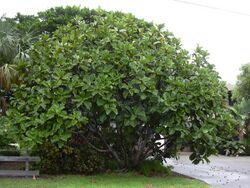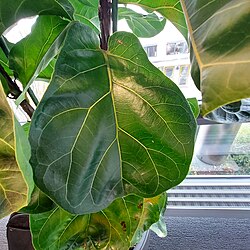Biology:Ficus lyrata
| Ficus lyrata | |
|---|---|

| |
| Scientific classification Error creating thumbnail: Unable to save thumbnail to destination
| |
| Kingdom: | Plantae |
| Clade: | Tracheophytes |
| Clade: | Angiosperms |
| Clade: | Eudicots |
| Clade: | Rosids |
| Order: | Rosales |
| Family: | Moraceae |
| Genus: | Ficus |
| Subgenus: | F. subg. Urostigma |
| Species: | F. lyrata
|
| Binomial name | |
| Ficus lyrata Warb.
| |
Ficus lyrata, commonly known as the fiddle-leaf fig, banjo fig, fiddle-leaved fig tree, lyre leaf fig tree, or lyre-leaved fig tree, is a species of plant in the mulberry and fig family Moraceae. It is native to western Africa, but is cultivated around the world as an ornamental plant.[1][2] It has received the Royal Horticultural Society's Award of Garden Merit.[3]
The leaves are variable in shape, but often with a broad apex and narrow middle, resembling a lyre or fiddle; they are up to 45 cm (18 in) long and 30 cm (12 in) broad (though usually smaller) with a leathery texture, prominent veins and a wavy margin.
The fruit is a green fig 2.5–3 cm (1-¼ in) diameter.
Distribution and habitat
F. lyrata is native to Benin, Cameroon, Gabon, Ghana, Guinea, Guinea-Bissau, Ivory Coast, Liberia, Nigeria, Sierra Leone, and Togo, where it occurs in moist lowland forests. It also occurs as an introduced species in the Canary Islands, El Salvador, and Trinidad and Tobago.[1][4]
Cultivation
It is a popular ornamental tree in subtropical and tropical gardens, and is also grown as a houseplant in temperate areas, where it usually stays shorter and fails to flower or fruit. It requires indirect natural light. It is hardy down to 10 °C (50 °F), so specimens may be placed outside during warm periods.[citation needed]
Indoor use
A commonly tricky houseplant despite its popularity, the fiddle-leaf fig does not respond well to being moved, especially from a spot where it is thriving. Being a tropical plant, it does not tolerate cold temperatures well or survive prolonged freezes. Proper drainage, adequate sunlight (direct but not harsh), and misting with water will help keep a fiddle-leaf fig bright green with its signature glossy finish.[citation needed]
Humidity and Temperature Requirements
The optimal relative humidity for the fiddle-leaf fig is between 25%-49%, but it can tolerate lower humidity. When it comes to the temperature requirements, the optimal temperature for the fiddle-leaf fig is between 65°F- 75°F (18°C- 24°C).[citation needed]
Light Requirements
Grown indoors, light is the most limiting factor for Ficus lyrata. It is a full sun plant (it grows in direct sun most of the day in the natural habitat), but it can also grow well indoors in bright indirect light.[citation needed]
Propagation
Ficus lyrata can be propagated in multiple ways:
- By division
- By stem cuttings, and
- By air layering
See also
References
- ↑ 1.0 1.1 1.2 IUCN SSC Global Tree Specialist Group & Botanic Gardens Conservation International (BGCI) (2022). "Ficus lyrata". IUCN Red List of Threatened Species 2022: e.T208115167A208354564. doi:10.2305/IUCN.UK.2022-1.RLTS.T208115167A208354564.en. https://www.iucnredlist.org/species/208115167/208354564. Retrieved 19 January 2024.
- ↑ Datiles, M. J.; Acevedo-Rodrígue, P. (15 December 2014). "Ficus lyrata (fiddle-leaf fig)". CAB International. doi:10.1079/cabicompendium.2412. https://www.cabidigitallibrary.org/doi/10.1079/cabicompendium.24125.
- ↑ "Ornamental AGM Plants April 2023". Royal Horticultural Society. April 2023. p. 46. https://www.rhs.org.uk/plants/pdfs/agm-lists/agm-ornamentals.pdf.
- ↑ "Ficus lyrata Warb.". Royal Botanic Gardens, Kew. https://powo.science.kew.org/taxon/urn:lsid:ipni.org:names:853158-1.
External links
| Wikimedia Commons has media related to Ficus lyrata. |
Wikidata ☰ Q1498748 entry
 |



